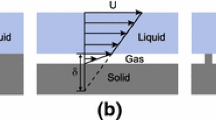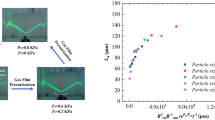Abstract
Boundary slippages occur on shearless solid surfaces. This property is related to fluid and solid surface properties. The special boundary condition provides a high flow velocity at the liquid–solid interface, which renders drag reduction characteristic and less foul adhesion at the surface. The chemical composition and microstructure of the surface determine the slippage property. For instance, the super-hydrophobic surface bio-mimicking of a lotus leaf is attributed to the micro-nanostructures and low-surface-energy materials in this plant. A steady air shield exists between the fluid flow and the super-hydrophobic surface. This air isolates the contact between the fluid and the surface. This behavior causes boundary slippage and foul release. Another case is the riblet-surface bio-mimicking of a sharkskin, which possesses a number of microgrooves. The surface not only stabilizes fluid flow at the interface that causes drag reduction but also prevents the breed of organisms.
Access this chapter
Tax calculation will be finalised at checkout
Purchases are for personal use only
Similar content being viewed by others
References
Kline SJ, Reyolds WC, Schraub FA, Runstadlers PW (1967) The structure of turbulent boundary layers. J Fluid Mech 30:741–773
Vinogradova OI (1995) Drainage of a thin liquid film confined between hydrophobic surfaces. Langmuir 11:2213–2220
Choi CH, Kim CJ (2006) Large slip of aqueous liquid flow over a nanoengineered superhydrophobic surface. Phys Rev Lett 96:066001
Joly L, Biben T (2009) Wetting and friction on surperolephobic surface. Soft Mater 5:2549–2257
Wu Y, Cai M, Li Z, Song X, Wang H, Pei X, Zhou F (2014) Slip flow of diverse liquids on robust superomniphobic surfaces. J Colloid Interface Sci 414:9–13
Ybert C, Barentin C, Cottin-Bizonne C, Joseph P, Bocquet L (2007) Achieving large slip with superhydrophobic surfaces: scaling laws for generic geometries. Phys Fluids 19:123601
Lee C, Choi CH, Kim CJ (2008) Structured surfaces for a giant liquid slip. Phys Rev Lett 101:064501
Lee C, Kim CJ (2009) Maximizing the giant liquid slip on superhydrophobic microstructures by nanostructuring their sidewalls. Langmuir 25:12812–12818
Wu Y, Xue Y, Pei X, Cai M, Duan H, Huck WTS, Zhou F, Xue Q (2014) Adhesion-regulated switchable fluid slippage on super-hydrophobic surfaces. J Phys Chem C 118:2564–2569
Wu Y, Liu Z, Liang Y, Pei X, Zhou F, Xue Q (2014) Switching fluid slippage on pH-responsive superhydrophobic surfaces. Langmuir 22:6463–6468
Wu Y, Liu Z, Liang Y, Pei X, Zhou F, Xue Q (2014) Photoresponsive superhydrophobic coating for regulating boundary slippage. Soft Matter. doi:10.1039/C4SM00799A
Wu W, Wang X, Wang D (2009) Alumina nanowire forests via unconventional anodization and super-repellency plus low adhesion to diverse liquids. Chem Commun (Camb) 1043–1045
Liu X, Wu W, Wang X, Luo Z, Liang Y, Zhou F (2009) A replication strategy for complex micronanostructures with superhydrophobicity and superoleophobicity and high contrast adhesion. Soft Matter 5:3097–3105
Wang D, Wang X, Liu X, Zhou F (2010) Engineering a titanium surface with controllable oleophobicity and switchable oil adhesion. J Phys Chem C 114:9938–9944
Pan S, Kota AK, Mabry JM, Tuteja A (2013) Superomniphobic surfaces for effective chemical shielding. J Am Chem Soc 135:578–581
Liu K, Jiang L (2012) Bio-inspired self-cleaning surfaces. Ann Rev Mat Res 42:231–263
Marmur A (2006) Super-hydrophobicity fundamentals: implications to biofouling prevention. Biofouling 22:107–115
Zhang H, Lamb R, Lewis J (2005) Engineering nanoscale roughness on hydrophobic surface—preliminary assessment of fouling behaviour. Sci Technol Adv Mat 6:236–239
Wong TS, Kang SH, Tang SK, Smythe EJ, Hatton BD, Grinthal A, Aizenberg J (2011) Bioinspired self-repairing slippery surfaces with pressure-stable omniphobicity. Nature 477:443–447
Epsteina AK, Wong T-S, Belisle RA, Boggsa EM, Aizenberg J (2012) Liquid-infused structured surfaces with exceptional anti-biofouling performance. PANS 109:13182–13187
Wilson PW, Lu W, Xu H, Kim P, Kreder MJ, Alvarenga J, Aizenberg J (2013) Inhibition of ice nucleation by slippery liquid-infused porous surfaces (SLIPS). Phys Chem Chem Phys 15:581–585
Kim P, Wong T, Alvarenga J, Kreder MJ, Adorno-Martinez WE, Aizenberg J (2012) Liquid-infused nanostructured surfaces with extreme anti-ice and anti-frost performance. ACS Nano 6:6569–6577
Magin CM, Cooper SP, Brennan AB (2010) Non-toxic antifouling strategies. Mater Today 13:36–44
Bixler GD, Bhushan B (2013) Fluid drag reduction with shark-skin riblet inspired microstructured surfaces. Adv Func Mater 23:4507–4528
Walsh MJ (1983) Riblets as a viscous drag reduction technique. AIAA J 21:485
Nitschke P (1983) Experimental investigation of the turbulent flow in smooth and longitudinal grooved tubes. AIAA J, NAS 1.15:77480
Bechert DW, Bartenwerfer M (1989) The viscous-flow on surfaces with longitudinal ribs. J Fluid Mech 206:105–129
Bechert DW, Bruse M, Hage W, Vanderhoeven JGT, Hoppe G (1997) Experiments on drag-reducing surfaces and their optimization with an adjustable geometry. J Fluid Mech 338:59–87
Lee SJ, Lee SH (2001) Flow field analysis of a turbulent boundary layer over a riblet surface. Exp Fluids 30:153–166
Bechert DW, Bruse M, Hage W (2000) Fluid mechanics of biological surfaces and their technological application. Exp Fluids 87:157–171
Carman ML, Estes TG, Feinberg AW, Schumacher JF Wilkerson W, Wilson LH, Callow ME, Callow JA, Brennan AB (2006) Engineered antifouling microtopographies—correlating wettability with cell attachment. Biofouling 22:11–21
Bers AV, Wahl M (2004) The influence of natural surface microtopographies on fouling. Biofouling 20:43–51
Long CJ, Schumacher Robinson PAC, Finlay JA, Callow ME, Callow JA, Brennan AB (2010) A model that predicts the attachment behavior of Ulva linzazoospores on surface topography. Biofouling 26:411–419
Efimenko K, Finlay J, Callow ME, Callow JA, Genzer J (2009) Development and testing of hierarchically wrinkled coatings for marine antifouling. ACS Appl Mater Interfaces 1:1031–1040
Schumacher JF, Carman ML, Estes TG, Feinberg AW, Wilson LH, Callow ME, Callow JA, Finlay JA, Brennan AB (2007) Engineered antifouling microtopographies—effect of feature size, geometry, and roughness on settlement of zoospores of the green alga Ulva. Biofouling 23:55–62
Schumacher JF, Aldred N, Callow ME, Finlay J A, Callow JA, Clare AS, Brennan AB (2007) Species-specific engineered antifouling topographies: correlations between the settlement of algal zoospores and barnacle cyprids. Biofouling 23:307–317
Virk PS, Merrill EW, Mickley HS, Smith KA (1967) The Toms phenomenon: turbulent pipe flow of dilute polymer solutions. J Fluid Mech 30:305–328
White CM, Mungal MG (2008) Mechanics and prediction of turbulent drag reduction with polymer additives. Annu Rev Fluid Mech 40:235–256
Lee H, Dellatore SM, Miller WM, Messersmith PB (2007) Mussel-inspired surface chemistry for multifunctional coatings. Science 318:426–430
Dalsin JL, Messersmith PB (2005) Bioinspired antifouling polymers. Mater Today 8:38–46
Zhang F, Liu S, Zhang Y, Chi Z, Xua J, Wei Y (2012) A facile approach to surface modification on versatile substrates for biological applications. J Mater Chem 22:17159–17166
Fan XW, Lin LJ, Dalsin JL, Messersmith PB (2005) Biomimetic anchor for surface-initiated polymerization from metal substrates, J Am Chem Soc 127:15843–15847
Hay ME (1996) Marine chemical ecology: what's known and what's next? J Exp Mar Biol Ecol 200:103–134
Liu M, Wang S, Wei Z, Song Y, Jiang L (2009) Bioinspired design of a superoleophobic and low adhesive water/solid interface. Adv Mater 21:665–699
Lin L, Liu M, Chen L, Chen P, Ma J, Han D, Jiang L (2010) Bio-inspired hierarchical macromolecule-nanoclay hydrogels for robust underwater superoleophobicity. Adv Mater 22:4826–4830
Xue ZX, Wang ST, Lin L, Chen L, Liu M, Feng L, Jiang L (2011) A novel superhydrophilic and underwater superoleophobic hydrogel-coated mesh for oil/water separation. Adv Mater 23:4270–4273
Feng L, Zhang Z, Mai Z, Ma Y, Liu B, Jiang L, Zhu D (2004) A superhydrophobic and superoleophilic coating mesh film for the separation of oil and water. Angew Chem Int Edit 43:2012–2014
Author information
Authors and Affiliations
Corresponding author
Editor information
Editors and Affiliations
Rights and permissions
Copyright information
© 2015 Springer-Verlag Berlin Heidelberg
About this chapter
Cite this chapter
Wu, Y., Wang, D., Zhou, F. (2015). Effect of Boundary Slippage on Foul Release. In: Zhou, F. (eds) Antifouling Surfaces and Materials. Springer, Berlin, Heidelberg. https://doi.org/10.1007/978-3-662-45204-2_7
Download citation
DOI: https://doi.org/10.1007/978-3-662-45204-2_7
Published:
Publisher Name: Springer, Berlin, Heidelberg
Print ISBN: 978-3-662-45203-5
Online ISBN: 978-3-662-45204-2
eBook Packages: Chemistry and Materials ScienceChemistry and Material Science (R0)




